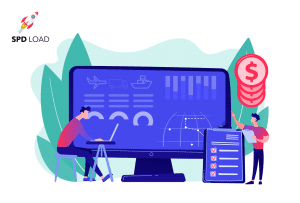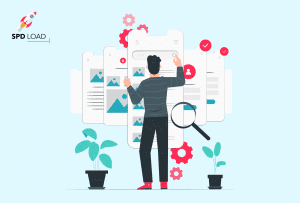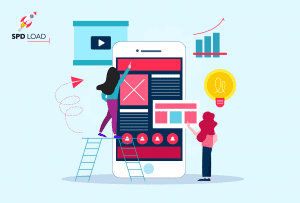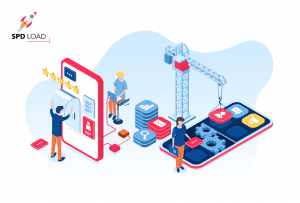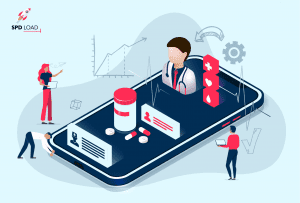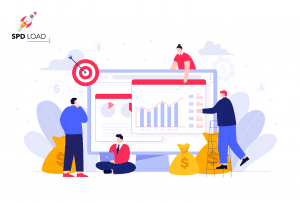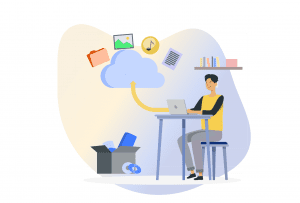What is a SaaS Product? – Ultimate Guide & Examples
- Created: Apr 25, 2025
- 13 min
Thinking of launching your own software product but not sure how to start? SaaS might be your best bet.
At SpdLoad, we have been providing SaaS development services for over 10 years now. Our clients scale successful SaaS platforms across industries like fintech, healthcare, e-commerce, and HR & project management tools.
Here, we dive into what a SaaS product is, its key features, and how to create one. We will also explore the pros and cons of the SaaS model and share some insightful market trends to help you shape your vision of the SaaS services market.
Learn more about how we approach SaaS development
What is a SaaS Product?
A SaaS product, or Software as a Service, is a cloud-based software solution that users can access online. It eliminates the need for physical installation on individual devices, allowing users to access the software from any internet-enabled device.
This model is highly effective for small businesses and enterprises, as it provides scalable solutions for various business operations such as customer relationship management, project management, and data storage.
SaaS products are typically offered on a subscription basis. The SaaS vendor manages updates and maintenance on their servers.
Many of your favorite internet platforms are SaaS applications – Google Apps, Dropbox, Canva, or Free Logo Creator. Discover some of the best SaaS startup ideas that are driving innovation in the tech industry.
Entrepreneurs began spreading the idea of the SaaS model in the 1990s. To date, it is one of the most relevant business distribution models.
If you’re deciding between software models, this comparison of the ASP model vs SaaS model can help you choose.
The best thing about SaaS software is that you don’t need any special equipment or specialists to use it. Go to the site, use the product, and grow profit. What could be easier than that?
As a result, Software as a Service has quickly become a popular way to provide value to users. And the market reacted. Large corporations like to acquire SaaS companies and their software tools.
For example, in 2018, Microsoft acquired GitHub for $7.5 billion, Adobe took over Marketo for $4.75 billion and Magento for $1.68 billion.
To become a successful player, you need to understand the basic concepts and dynamics of software services. Check out our insights on custom software development cost that cover what drives prices and how to manage expenses.
Key Features of SaaS Products
SaaS products have become essential for modern businesses due to their flexibility, accessibility, and continuous innovation. The following are the core features that define successful SaaS products:
Feature | Description |
|---|---|
| Multi-tenancy | Single software instance serves multiple customers securely |
| Scalability | Easily adjusts resources and users as business needs change |
| Automatic updates | Continuous delivery of new features and security patches |
| Integration | Connects with other software and services via APIs |
| Security & compliance | Advanced security, encryption, and regulatory compliance |
| Customization | User-friendly personalization and low-code/no-code options |
| Analytics & reporting | Built-in tools for data-driven insights |
| High availability | Reliable uptime and performance |
| User experience | Intuitive UI, mobile compatibility, and accessibility |
| Customer support | 24/7 support, onboarding, and self-service resources |
| Subscription billing | Flexible, usage-based pricing |
| Rapid feature delivery | Fast, iterative updates and innovation |
| Core functionality | Delivers on the main promise—solving a key business problem |
What Are The Benefits and Drawbacks of SaaS Products
SaaS products offer significant advantages in cost, flexibility, and ease of use, but organizations must carefully consider potential drawbacks related to control, security, and integration before adopting them.
Benefits of SaaS
The advantages of this business model include:
Accessibility
The cloud computing model is based on client-centricity. Your service’s availability is limited only to an Internet connection. Your customers can entertain or work by being as mobile as possible.
Endless integrations
The number of cloud services is constantly growing. Thus, in 2025, software integrations will be a must-have requirement. It is an advantage of SaaS for organizations because, on average, organizations with over 250 employees use 100 SaaS products. Companies that have up to 50 employees use around 50 SaaS products.
Easy scaling
Metrics and complex calculations are essential for growth. However, the smooth growth of features is only possible with cloud-based Software. It is crucial for any MVP product.
Data safety
Cloud security standards are very high. By 2025, Gartner says that 99% of failures in cloud security will be due to mistakes made by customers, not technical issues. 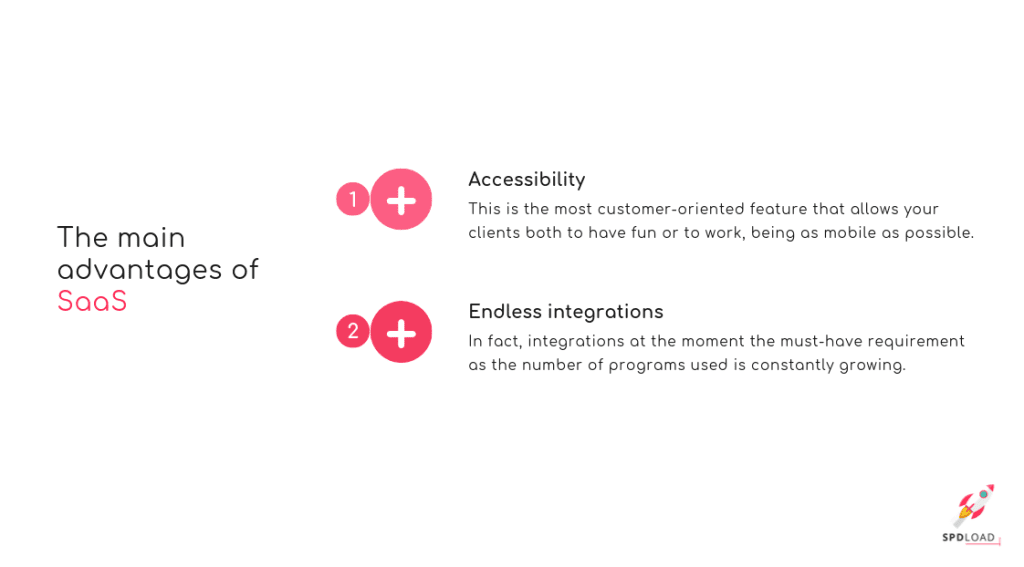
Drawbacks of SaaS
Despite multiple benefits, there are certain potential drawbacks to be aware of:
Security challenges
Paradoxically, security is both a strength and a weakness of SaaS apps.
Why? Technical solutions like ISO / IEC 27017 standards don’t guarantee avoiding user data leakage.
Anything can be the cause, from weak passwords to phishing attacks.
Government regulations
Many SaaS solutions deal with data that is subject to state regulations. Not all SaaS providers comply with specific industry regulations, which can be problematic for organizations with strict compliance requirements.
Thus, meeting state requirements, like compliance with GDPR or HIPAA, might be a technical challenge.
For more information about compliance, check out our article where we highlight the best HIPAA-compliant chat apps.
Integration and compatibility challenges
Integrating SaaS products with existing systems can be complex and may not always work seamlessly. Compatibility issues with operating systems or browsers can further hinder smooth adoption and use. 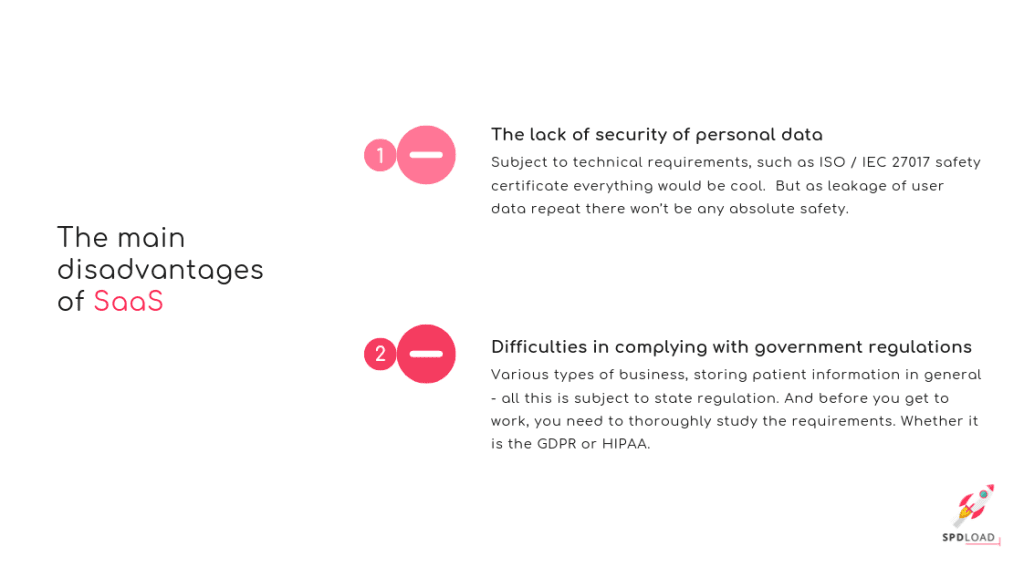
8 Main Types Of SaaS
The SaaS model is singled out as a separate market direction for a reason. The diversity of possibilities in the cloud computing market is astonishing.
Based on this, many SaaS marketing agencies are also changing strategies to align with their customers’ needs.
Let’s explore some of the available options.
Type | Description | Examples |
| The CRM or customer relationship management software | In 2024, 94% of businesses used CRM software to automate their sales and marketing processes. The core features include a lead pipeline and an analytic dashboard. | Salesforce and HubSpot are the trendsetters in this area. Explore how CRM in recruiting can transform your hiring process and improve candidate relationships. |
| The ERP or enterprise resource planning software | It’s a system that manages every business process in real time. By 2026, the market is expected to grow to $79 billion, making your SaaS vendor popular from day one. | Oracle and Acumatica are famous players in this market. |
| The Project management software | This type of SaaS application helps PMs to collaborate with their teams. This niche is expected to grow to $4.33 billion by 2023, making it an excellent spot to start your own project. | The strongest competitors in this field are Jira, ProWorkflow, nTask, ProofHub, and their alternatives. Explore the best project management software to find solutions tailored to your business needs. |
| The financial management software | The financial management software niche contains SaaS products covering all payment procedures. Making a payment and reporting on after-payments are single-click processes. This market is predicted to reach $20 billion by 2026. | Great news for such SaaS providers as Xero, Tipalti or Refrens |
| The collaboration software | This type of cloud software includes features for communication and sharing information, like Flipsnack. The market is expected to be worth $16 billion by the end of 2025, which is large enough to carve your own piece of the pie. | Miro and I done this are good examples of collab software. |
| The eCommerce software | This kind of Software has everything you need to do business on the Internet. The core features include goods management and payment integrations. The e-commerce market is forecasted to reach $21.4 billion by 2026. It creates synergy with Internet-based shopping since by 2040, 95% of customers will make purchases online. | Analyze such trendsetters as Shopify, BigCommerce, or SureCart. |
| The vertical SaaS | It’s a specific SaaS product for a particular field. It can be a comic store, martial arts dojo, grooming salon, or any other business. Vertical SaaS is a generic name for niche products made to optimize specific business processes. In the healthcare sector, for example, some of the prominent SaaS companies are Prognocis (by CitiusTech) and DrChrono EHRs. | |
| Mobile device management software | It’s a SaaS product called Mobile Device Management, which provides devices with corporate resources and pushes enterprise policies on the device fleets. | Scalefusion Android MDM is an example. |
The SaaS industry is growing rapidly. Learn how to start a SaaS business from scratch.
Explore our SaaS services today
SaaS Development and Launch Process
To develop and launch a SaaS business, founders need to start with careful planning and then execute the idea. Just like with any other business, actually. The process is similar to launching traditional software. However, SaaS introduces unique challenges and considerations due to its cloud-based nature, subscription model, and ongoing operational requirements. Here’s a comprehensive checklist of the process:
1. Ideation & validation
- Market research: identify pain points and validate demand
- Competitor analysis: study existing solutions
- MVP definition: determine core features for the Minimum Viable Product
- Business model: decide on pricing strategy (subscription tiers, freemium, etc.)
2. Planning phase
- Roadmap creation: short-term and long-term feature planning
- Tech stack selection: choose between a monolithic or a microservices architecture
- Team assembly: developers, designers, product managers
- Budgeting: estimate development and operational costs
3. Development process
- UI/UX design: wireframing → prototyping → final designs
- Backend development:
- Database architecture
- API development
- Authentication systems
- Payment integration
- Frontend development: responsive web interface
- Cloud infrastructure setup: AWS, Azure, or Google Cloud configuration
- Security implementation: data encryption, compliance measures
4. Testing phase
- Unit testing: individual component testing
- Integration testing: system-wide functionality checks
- Performance testing: load and stress tests
- Security testing: vulnerability assessments
- User acceptance testing: real user feedback collection
5. Pre-launch preparation
- Beta program: limited release to gather feedback
- Documentation: user guides, API documentation
- Marketing assets: website, demo videos, case studies
- Customer support setup: ticketing system, knowledge base
- Analytics integration: usage tracking and metrics
6. Launch strategy
- Soft launch: limited release to test operations
- Marketing campaigns: content marketing, paid ads, PR
- Onboarding process: email sequences, in-app tutorials
- Pricing optimization: early adopter discounts, if applicable
7. Post-launch activities
- Continuous monitoring: performance and uptime tracking
- Feedback collection: user surveys, NPS scores
- Iterative improvements: regular feature updates
- Scaling infrastructure: as the user base grows
- Customer retention: engagement strategies, loyalty programs
Our team at SpdLoad guides businesses through every step of the SaaS application development.
First, we get to know your vision and requirements to make sure that the development process aligns with your business goals.
Then, we move on to the project discovery phase, where we identify user profiles, core characteristics, key features, and functions of your app, as well as opportunities and challenges.
Once the discovery is done, our designers conduct thorough user research to understand the preferences of your target audience and design a SaaS application. We create intuitive and visually appealing designs based on gathered data that enhance customer satisfaction and drive engagement.
Then, we move on to the development and testing stages, preparing the MVP that is ready for scaling and the fundraising process.
If needed, you can also count on our ongoing support and maintenance to keep your app up-to-date, secure, and optimized for performance.
Supercharge Your Team with Top IT Talent.
What are the Challenges of Developing a SaaS Product?
Developing a SaaS product presents a unique set of technical, business, and operational challenges. The most significant challenges include:
Challenge | Description | Solution |
|---|---|---|
| Scalability & performance | Handling growing user traffic without downtime or lag. | Use auto-scaling (AWS, Kubernetes), CDN, and load testing. |
| Multi-tenancy architecture | Serving multiple customers securely on a shared infrastructure. | Implement data isolation (schema-per-tenant, row-level security). |
| Subscription & billing | Managing recurring payments, prorations, dunning, and upgrades. | Integrate Stripe, Chargebee, or Recurly for automated billing. |
| Security & compliance | Protecting user data (GDPR, HIPAA, SOC 2) and preventing breaches. | Encryption, RBAC, regular audits, and compliance certifications. |
| Zero-downtime deployments | Updating software without disrupting active users. | CI/CD pipelines, feature flags, and blue-green deployments. |
| Customer onboarding & Retention | High churn risk if users struggle to adopt the product. | In-app tutorials, guided onboarding flows, and analytics-driven engagement. |
| High operational Costs | Cloud expenses (AWS/GCP) and support costs scale with growth. | Optimize cloud resources, use serverless, and monitor spending. |
| Competition & differentiation | Standing out in saturated markets (e.g., CRM, project tools). | Niche targeting, AI features, and superior UX/UI. |
| Data migration & integrations | Users expect seamless API connections (Slack, Zapier, etc.). | Build a robust REST API and offer pre-built integrations. |
| Pricing strategy | Choosing between Freemium, Tiered, or Usage-based pricing. | A/B test pricing models and track LTV/CAC. |
Case Study: How We Helped Haystax Level Up Their Security Analytics Platform
At SpdLoad, we’ve built all kinds of SaaS products, and one of the most exciting projects we’ve worked on is for Haystax, a company known for top-tier security analytics and risk management software.
They came to us with a big ask: help them build a smarter, more intuitive platform that could handle complex risk data and make it easily actionable. In this security analytics platform development case study, we tell how our team tackled that project. Here is the short story:
Challenge 1: Making Mapbox Work for Security
Haystax needed to visualize sensitive data on a map — think assets, incidents, and threats — in a way that was fast, accurate, and crystal clear.
The catch? Mapbox isn’t a plug-and-play tool when you’re dealing with high-stakes security data. It took serious customization and smart integration to make it work seamlessly.
We got it done. Users can now see, sort, and interact with geographic data like never before — all in real-time.
Challenge 2: Building a Complex Assessments App
Haystax also needed a flexible Assessments tool for collecting and analyzing detailed reports. But this wasn’t your average survey builder.
We had to develop features like:
- Dependent questions that change based on user input
- Repeating sections for recurring data
- Document uploads
- Partial saves (because real-world users don’t always finish in one go)
- Mandatory questions and submission rules
It’s now a powerful engine for deep, structured evaluations — and it’s as easy to use as filling out a form.
The final product has a seamless and intuitive interface. The dashboard gives users an at-a-glance view of the most critical data. Plus, specialized modules like Assessments, Field Reports, Assets, and Events offer everything they need to stay in control, stay ahead, and respond fast. 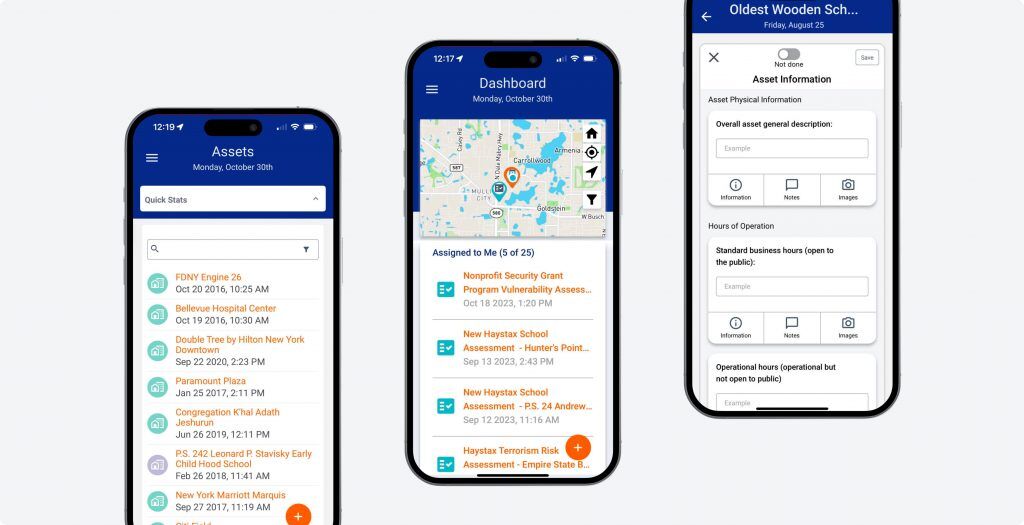
SaaS Market Trends and Future Outlook
The Precedence Research SaaS market report outlines that the global software as a service market size is calculated at $408.21 billion in 2025 and is forecasted to reach around $1,251.35 billion by 2034.
The report highlights several key factors driving the SaaS market’s rapid growth.
One of the most important SaaS market drivers is cost-efficiency
SaaS significantly lowers IT infrastructure expenses and shortens deployment timelines, which makes it especially appealing to companies looking to scale without significant upfront investments in hardware or software. Large enterprises are leading this trend as they seek cost-effective ways to support growth.
The broader shift to cloud computing is another major driver
With SaaS being inherently cloud-based, the surge in cloud adoption, particularly private cloud solutions, which claimed 44% of the market in 2024, is fueling SaaS expansion.
This shift from on-premises software to cloud-based tools also brings added benefits like improved flexibility, accessibility, and security, making SaaS an attractive choice for a wide range of industries.
Applications like CRM, ERP, HR, analytics, and communication tools are at the forefront, with CRM standing out due to the growing demand for customer-centric platforms.
As more businesses digitize their operations, the need for systems that support automation, policy integration, and remote collaboration becomes critical. SaaS excels in embedding these capabilities directly into workflows.
The global rise of SMEs and startups is also contributing to market growth
For example, South Korea had 7.3 million SMEs in 2023, many of which turn to SaaS for flexible, plug-and-play solutions. In Europe, increasing startup investments, where seed funding doubled between 2020 and 2021, are further boosting adoption.
Investor interest is another key factor
Venture capital funding for SaaS hit $94 billion in the US alone in 2021, helping companies expand their offerings and enter new markets. Mergers, acquisitions, and strategic partnerships are also accelerating innovation and market penetration.
At the same time, cloud-based software becomes more user-friendly and customizable, which makes it appealing even to non-technical users, driving mass adoption.
Finally, with growing concerns over data privacy and compliance, industries such as banking, finance, and healthcare are increasingly adopting private cloud SaaS solutions to meet stricter regulatory standards while enjoying the benefits of the model. 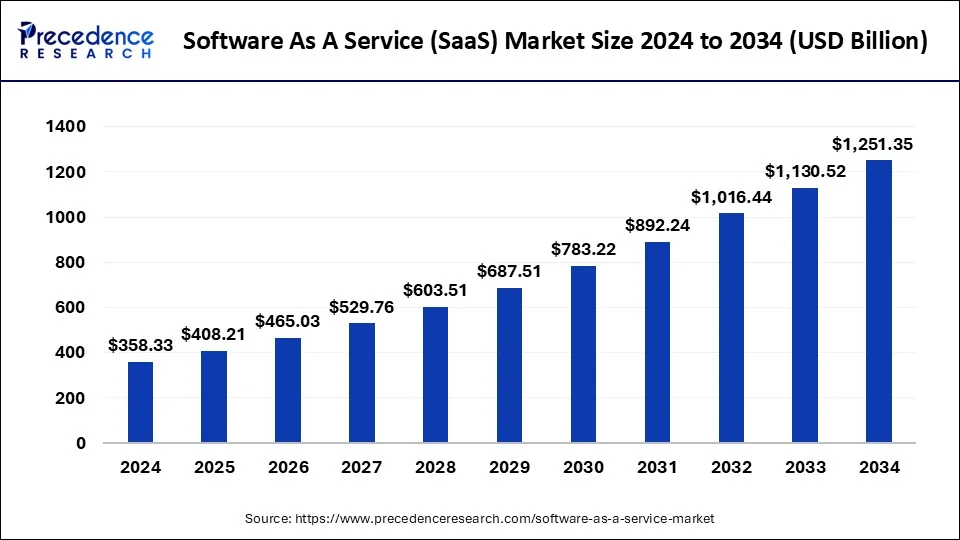
The Best SaaS Companies
G2 listed the best software companies in 2025. The ranking results are based on user reviews. Let’s take a look at the top 5 SaaS companies.
Salesforce Sales Cloud
Salesforce Sales Cloud is one of the most widely used CRM platforms, designed to streamline the sales process from lead generation to deal closure. It offers powerful tools for automation, forecasting, reporting, and pipeline management.
Businesses can customize workflows and integrate third-party tools to suit their specific needs.
Salesforce is especially popular among large enterprises for its scalability and ecosystem of connected apps. Its user-friendly interface and strong analytics make it a go-to for sales teams across industries.
KnowBe4 Security Awareness Training
KnowBe4 Security Awareness Training helps organizations protect themselves from cyber threats by educating employees on phishing, malware, and other risks.
Its interactive modules, real-world simulations, and detailed reporting tools make it an effective solution for building a security-first culture. KnowBe4 continuously updates its training based on emerging threats, keeping teams informed and prepared. It’s widely adopted across sectors like finance, healthcare, and education.
The platform is especially valued for turning human error from a risk into a line of defense.
Asana
Asana is a project and task management platform that empowers teams to plan, track, and manage their work in one place. It supports everything from daily to-dos to complex project timelines, with features like boards, timelines, automation rules, and workload views.
Asana is popular for its clean design and ease of use, especially among marketing, product, and operations teams. It integrates with many other tools, including Slack, Google Drive, and Zoom.
Teams use it to stay aligned, hit deadlines, and reduce back-and-forth communication.
Motive
Motive (formerly KeepTruckin) offers a connected operations platform focused on transportation, logistics, and field service industries. Its core product is fleet management, combining GPS tracking, vehicle diagnostics, and driver safety monitoring.
Motive’s tools help companies improve compliance with regulations, reduce fuel costs, and increase fleet efficiency. It also offers features like dashcams and automated reporting to enhance operational visibility.
The platform is used by both small businesses and large enterprises managing vehicle-based operations.
Smartsheet
Smartsheet is a collaborative work data management tool that blends the familiarity of spreadsheets with advanced project management capabilities. It allows teams to build and automate workflows, assign tasks, track progress, and generate reports in real time.
Smartsheet supports a wide range of use cases, from marketing campaigns and IT operations to strategic planning. Its flexibility makes it popular across industries, especially where visibility and cross-functional coordination are key.
The project management software also includes dashboards, forms, and integrations with tools like Microsoft Teams and Salesforce.
What’s Next?
The SaaS market continues to grow rapidly, driven by AI, automation, and remote work trends.
For businesses, adopting SaaS means faster deployment, continuous innovation, and a focus on core operations rather than IT management. Whether for startups or enterprises, SaaS offers a flexible, cost-effective way to leverage cutting-edge technology. However, software projects fail due to unclear goals.
That’s why validating your idea upfront is so important.
If you want to build your minimum viable SaaS product, SpdLoad specializes in streamlined development to turn ideas into real products that customers love.
Contact us to schedule a free consultation to discuss your SaaS product, its goals, and requirements.
Planning your own business? Here are essential tips on how to build a startup from scratch to guide you.





